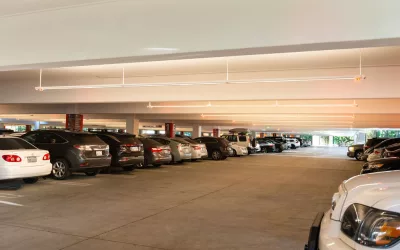Dynamic Pricing and the ‘value-add benefits’.
Since the introduction of self-parking, well over half a century ago, parking owners and operators struggle to realize the full value of their assets.
In the early days, the challenges were largely around accounting. Just as with any cash business, it was difficult to make sure that all the money that was being collected was making its way into the cash register.
Today, owners and operators still struggle to maximize their parking revenue. However, the challenges are very different. Equally, parking owners manage an incredibly valuable asset without a mechanism for fully realizing that value. This is particularly true for downtown parking facilities in urban areas.
Ultimately, the problem is that unlike other products and services, it is very difficult to apply market-driven pricing to parking a.k.a. dynamic pricing. Whereas, the price of such commodities as food, clothing, or even entertainment can be adjusted based on factors. For example, demand, or cost, or other market factors. However, the price of parking remains relatively static. In contrast, until recently, there isn’t a good way to constantly measure parking demand. Not to mention adjusting prices as demand rises and falls. The best owners and operators have been able to do, is to review historical data and predict future behavior. Thus, allowing them to set prices accordingly.
Undoubtedly, it’s easy to see the limitations of this approach. This pricing method is based on little more than guesswork. No matter how much data you have about past parking demand, it’s impossible to know for certain how much demand there will be in the future.
Technology To The Rescue
Parking Guidance
The good news for parking owners and operators is that these challenges have finally been conquered. The ‘parking technology’ age, that is transforming the parking industry, is providing particularly important benefits when it comes to dynamic pricing. And the key to success is parking guidance sensors that are becoming increasingly more popular over the past few years.
Without a doubt, one of the key roles of parking guidance sensors is to monitor utilization. The most visible manifestation of this is the series of lights that indicate to drivers whether a particular space is available. If so, which type of parking utilization is acceptable. Typically, a green light indicates that the space is available. Whereas a red means it’s full. Likewise, generally blue means the space is reserved for accessible parking. However, most systems can be tailored to each facility’s unique needs.
Parking Software Integration
Importantly, these same sensors can also work in conjunction with parking software to analyze utilization. This aims to help owners and operators better manage their facilities. Now, that parking software can be customized to continuously monitor occupancy levels and automatically modify pricing in real-time. If occupancy rises above a certain level of occupancy, the price rises accordingly. Likewise, if it falls again the price drops. For the first time, we can base pricing on utilization, rather than on predictions of occupancy.
Communication
Of course, as with parking guidance systems, communication is required for the system to work. Just as the sensors communicate in real-time with signs at facility entrances (so parkers know how many open spaces are available on each floor), the system also communicates how much parking costs at that exact moment. You can’t have drivers entering a parking lot or garage expecting to pay one amount, only to be charged more when they leave.
With these parking technologies, dynamic pricing can be achieved in any parking facility. Ground-based parking sensors are now being used in outdoor lots and even in on-street metered spaces. Likewise, ceiling-based sensors hang above parking spaces in garages and can be used to manage parking systems.
Good News for Owners & Operators
It’s obvious why dynamic pricing is good news for parking owners and operators. They can finally earn the actual value of their parking assets. In fact, the parking technology was installed for the first time last spring in downtown Los Angeles, and the owner immediately benefited. Over the first two months of implementation, revenue increased by 100% each month. It began settling at around 35% per month. When the owner factored in decreased labor and associated costs permitted by the system, increased profits inched over 50% per month.
Interestingly, business actually picked up since the owner installed the dynamic pricing package. Drivers seem to appreciate knowing that the rates they are being charged. Perhaps because they are based on the actual value of the space, and not some arbitrary number.
Needless to say, the owner is delighting in their results. Additionally, competitors have started staking notice. Not only is that owner installing dynamic pricing systems to other lots, but other parking facilities in the area are also starting to install the system.
What about municipalities?
Dynamic pricing also promises benefits to municipalities. Obviously, cities can install the system in their garages and lots, but they can also use the parking technology in on-street spaces that are served by smart parking meters. On-street applications work the same way, with sensors measuring occupancy and communicating that information to smart meters, which then set pricing accordingly. Cities and towns can enjoy important revenue benefits from dynamic pricing.
And the benefits extend beyond revenues. By being able to adjust prices on the fly, municipal parking planners can use parking pricing more effectively to support downtown business development. Typically, parking planners set on-street prices in central business districts at levels designed to assure that at least 15% of the spaces are available at any given time. The idea is to help local businesses by make sure that it’s easy for shoppers to find parking. Now, with dynamic pricing, that strategy becomes much easier to implement and manage. If occupancy gets too high in the CBD, the system can automatically raise prices to encourage long-term parkers to use more remote parking spaces. If occupancy gets too low, the prices can be dropped to encourage visitors to park adjacent to downtown businesses. In the coming years dynamic pricing will become an important element of most communities’ efforts to support downtown businesses.
Finally, parkers will benefit in a few ways. Most notably, drivers who typically park in low utilization lots will no longer pay more than they should for parking. With dynamic pricing, when a garage or lot empties, the price of parking will go down. Of course, the sensors that are managing the system continue to guide drivers into open spaces too, which makes the entire parking experience more convenient and pleasant.
Added Value
Moving forward, systems will be able to offer parkers more amenities. For instance, if a driver overstays the amount of time for which they have paid, the system will send an alert via that driver’s smart phone. The driver can then decide to pay for more parking or remove their vehicle. Enforcement officers will be notified if the driver ignores the alert.
Owners and operators soon will be able to offer parkers loyalty programs through apps on smart phones. Through these programs they can commence offering premier parking benefits like preferred parking, discounts, and added services such as a valet service. They’ll also guide parkers back to their vehicles if they forget where they parked. There are numerous benefits that can be provided through this greater connectivity with parkers, and owners and operators can build programs around the unique requirements of their customers.
And in the future, these benefits will grow exponentially. We are entering the era of connected cars and self-driving vehicles. There is no doubt that sensor-based networks are the key to the success of these efforts. In fact, they are the tool that connects all of a community’s parking spaces to the transportation grid.
Of course, not all sensor systems will manage dynamic pricing. While accuracy is essential in parking guidance systems, it’s particularly important when the price of parking is being adjusted on the fly. Inaccurate systems cost owners and operators thousands by improperly dropping prices when occupancy is too low. With dynamic pricing, anything below 99% accuracy is unacceptable.
Dynamic pricing provides extraordinary benefits to owners and operators, cities and towns, and even to parkers. It’s a concept whose time has come, and we finally have the technology at our disposal to make it a reality.



0 Comments